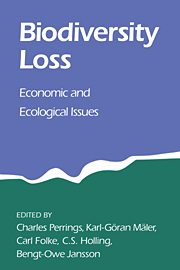Book contents
- Frontmatter
- Contents
- Foreword
- Preface
- List of contributors
- Introduction: framing the problem of biodiversity loss
- PART I CONCEPTUALISING DIVERSITY AND ECOSYSTEM FUNCTIONS
- PART II INTEGRATING ECOLOGY AND ECONOMICS IN THE ANALYSIS OF BIODIVERSITY LOSS
- PART III ECONOMIC ISSUES
- PART IV CONCLUSIONS
- References
- Index
Foreword
Published online by Cambridge University Press: 05 June 2012
- Frontmatter
- Contents
- Foreword
- Preface
- List of contributors
- Introduction: framing the problem of biodiversity loss
- PART I CONCEPTUALISING DIVERSITY AND ECOSYSTEM FUNCTIONS
- PART II INTEGRATING ECOLOGY AND ECONOMICS IN THE ANALYSIS OF BIODIVERSITY LOSS
- PART III ECONOMIC ISSUES
- PART IV CONCLUSIONS
- References
- Index
Summary
Resource economists typically view the natural environment through the lens of population ecology. Since the focus there is the dynamics of interacting populations of different species, it is customary to take the background environmental processes as exogenously given. The most wellknown illustration of this viewpoint is the use of the logistic function for charting the time path of the biomass of a single species offish enjoying a constant flow of food. Predator-prey models (e.g., that of Volterra) provide another class of examples: as do the May-MacArthur models of competition among an arbitrary number of species.
One or more of the populations in question may have a value. The value may be utilitarian (e.g., as a source of food or as a keystone species), it may be aesthetic, or it may be intrinsic: Indeed, it may be all these things. In some cases the populations would be valued directly (we would then regard them as consumption goods), in others indirectly (in these cases they are capital goods). Depending on the context, the flow of value could be a function of the rate at which a population is harvested, or it could be a function of the population size; in many cases, it would be a function of both. For example, annual commercial profits from a fishery depend not only on the rate at which it is harvested, but also on the stock of the fishery, because unit harvesting costs are typically low when stocks are large and high when stocks are low.
- Type
- Chapter
- Information
- Biodiversity LossEconomic and Ecological Issues, pp. vii - xPublisher: Cambridge University PressPrint publication year: 1995
- 1
- Cited by



